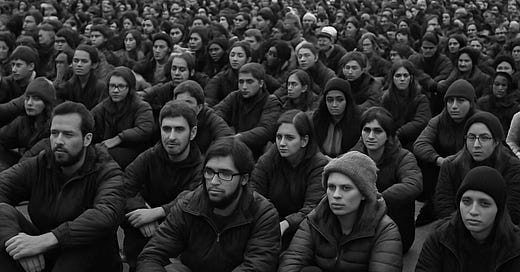Since the day I watched George Floyd be murdered on live television, I have taken to the streets in protest more times than I can count. Each time, it was not out of hatred or chaos, but out of a longing for justice. And in those moments, I learned something most people watching from their couches or scrolling through newsfeeds don't understand: protests are not monoliths. They're living, breathing battlegrounds filled with complexity.
I want to speak now to those who are skeptical. Particularly to those who supported Liz Cheney, Adam Kinzinger, or who still believe that the rule of law, civic order, and decency are American values worth defending. This message is for you.
Because what we are facing in this moment requires more than hashtags or slogans. It requires tactics. Discipline. Clarity. And perhaps most importantly, stillness.
The Six Groups at Every Protest
At every protest I’ve attended, I have seen at least six distinct groups show up:
The Protesters. The people who are grieving, angry, and trying to make their voices heard.
Law Enforcement. Most come sincerely to protect lives and property. I have spoken with many of them. They don’t want violence. They want order.
Counter-Protesters. They disagree with the message. And in a democracy, that’s okay. Heated words get exchanged, but police usually keep both groups safe.
Bad Faith Actors Pretending to Be Protesters. These individuals come to discredit the protest by starting fires, breaking windows, or attacking people. They do not represent the movement.
Bad Faith Actors from the Opposition. They show up pretending to be counter-protesters, attacking real activists to provoke chaos.
Spectators and Opportunists. They come to loot, record videos, or simply feed off the tension.
We need to stop letting the worst actors define what protest looks like. And we need to give law enforcement the tools to protect the real activists.
Sit Down. Be Counted. Take Space.
Recently, I made a simple but radical suggestion to my local law enforcement: what if those of us who were there for the right reasons just sat down?
What if we sat in?
Not in weakness. But in strength. In clarity. In peace.
They agreed.
They told me this would help them immediately identify who was there to protest peacefully and who was trying to hijack the moment for chaos. And they were right.
A crowd that is seated is a crowd that cannot be mistaken for a mob. A protest that takes space quietly sends a message louder than broken glass ever could.
Historical Context: Sitting as Resistance
We’re not the first to think of this. Sitting as protest has a long and noble history:
In 1960, four Black students sat at a Woolworth's lunch counter in Greensboro, NC, refusing to leave. Their quiet defiance launched a nationwide sit-in movement that forced businesses to desegregate.
Mahatma Gandhi used seated, nonviolent resistance to confront British colonialism in India, proving that stillness can shake an empire.
Occupy Wall Street demonstrators physically took space to demand justice for the 99%.
Black Lives Matter activists have used sit-ins at courthouses and public spaces to keep the spotlight on systemic injustice.
Stillness has always been a signal of moral clarity. When we sit, we declare: I am not running. I am not hiding. I am not afraid.
Why We Must Sit Now
Today, in the face of increased threats from ICE, political division, and growing authoritarian sentiment, we need to reclaim the image of protest. We must sit, so that there is no possible way that donald trump can unleash his military upon us without looking like a damn fool.
When we sit:
We show we are unarmed.
We give officers the ability to identify agitators.
We make our message impossible to confuse with violence.
We invoke history and align ourselves with generations of peaceful resistance.
It may feel counterintuitive. But taking up space peacefully is one of the most radical things we can do. It tells the truth when others are lying. It holds the line when others try to blur it.
We don’t need to match the rage of bad faith actors. We need to meet their chaos with grounded courage.
Conclusion: Sit Like You Mean It
This is a call to the real protestors, the defenders of democracy, the people who are tired but still standing. Let’s sit.
Let’s sit to protect each other. Let’s sit to honor the legacy of those who came before us. Let’s sit to make our message clear, undeniable, and unforgettable.
Let’s sit in, so that we can stand up—stronger, together.
Namaste
In solidarity
Renay Grace




